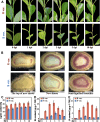DkWRKY transcription factors enhance persimmon resistance to Colletotrichum horii by promoting lignin accumulation through DkCAD1 promotor interaction
- PMID: 38407659
- PMCID: PMC10897097
- DOI: 10.1007/s44154-024-00154-0
DkWRKY transcription factors enhance persimmon resistance to Colletotrichum horii by promoting lignin accumulation through DkCAD1 promotor interaction
Abstract
Persimmon anthracnose, a severe disease caused by the hemibiotrophic fungus Colletotrichum horii, poses a substantial threat to China's persimmon industry. Previous research showed that 'Kangbing Jianshi' cultivar exhibits strong resistance to anthracnose. Notably, 'Kangbing Jianshi' branches exhibit greater lignification compared with the susceptible 'Fuping Jianshi' cultivar. In this study, higher lignin content was observed in 'Kangbing Jianshi' compared with 'Fuping Jianshi', and this difference was associated with disease resistance. Transcriptome and metabolome analyses revealed that the majority of differentially expressed genes and differentially accumulated metabolites were primarily enriched in the phenylpropanoid biosynthesis and lignin synthesis pathways. Furthermore, significant upregulation of DkCAD1, a pivotal gene involved in lignin metabolism, was observed in the resistant cultivar when inoculated with C. horii. Transient overexpression of DkCAD1 substantially increased lignin content and improved resistance to C. horii in a susceptible cultivar. Furthermore, through yeast one-hybrid (Y1H) assays, we identified two WRKY transcription factors, DkWRKY8 and DkWRKY10, which interacts with the DkCAD1 promoter and induces its activity. Overexpression of DkWRKY8 and DkWRKY10 not only increased leaf lignin content but also enhanced persimmon tolerance to C. horii. Moreover, the expression levels of DkCAD1, DkWRKY8, and DkWRKY10 were significantly increased in response to salicylic acid and jasmonic acid in the resistant cultivar. These findings enhance our understanding of the molecular functions of DkWRKY8, DkWRKY10, and DkCAD1 in persimmons, as well as their involvement in molecular breeding processes in persimmons.
Keywords: Colletotrichum horii; DkCAD1; DkWRKY; JA; Lignin; Persimmon; SA.
© 2024. The Author(s).
Conflict of interest statement
The authors declare that they have no competing interests.
Figures








Similar articles
-
Molecular and Morphological Characterization of Colletotrichum Species in the Colletotrichum gloeosporioides Complex Associated with Persimmon Anthracnose in South Korea.Plant Dis. 2018 May;102(5):1015-1024. doi: 10.1094/PDIS-10-17-1564-RE. Epub 2018 Mar 23. Plant Dis. 2018. PMID: 30673381
-
Identification and Observation of Infection Processes of Colletotrichum Species Associated with Persimmon Anthracnose in Guangxi, China.Plant Dis. 2023 Jun;107(6):1670-1679. doi: 10.1094/PDIS-06-22-1372-SR. Epub 2023 Jun 8. Plant Dis. 2023. PMID: 36350725
-
Genome Sequence Resource of the Causal Agent of Persimmon Anthracnose, Colletotrichum horii Strain SD010 from China.Plant Dis. 2022 Feb;106(2):730-733. doi: 10.1094/PDIS-05-21-1049-A. Epub 2022 Feb 6. Plant Dis. 2022. PMID: 34661446
-
Identification and characterization of Colletotrichum species associated with anthracnose on persimmon in Brazil.Fungal Biol. 2022 Mar;126(3):235-249. doi: 10.1016/j.funbio.2021.12.003. Epub 2021 Dec 15. Fungal Biol. 2022. PMID: 35183340
-
Trends in lignin modification: a comprehensive analysis of the effects of genetic manipulations/mutations on lignification and vascular integrity.Phytochemistry. 2002 Oct;61(3):221-94. doi: 10.1016/s0031-9422(02)00211-x. Phytochemistry. 2002. PMID: 12359514 Review.
Cited by
-
Transcriptome and VcCADs gene family analyses reveal mechanisms of blight resistance in rabbiteye blueberry.Front Plant Sci. 2025 Jun 18;16:1601658. doi: 10.3389/fpls.2025.1601658. eCollection 2025. Front Plant Sci. 2025. PMID: 40606482 Free PMC article.
-
A transcription factor, PbWRKY24, contributes to russet skin formation in pear fruits by modulating lignin accumulation.Hortic Res. 2024 Oct 18;12(2):uhae300. doi: 10.1093/hr/uhae300. eCollection 2025 Feb. Hortic Res. 2024. PMID: 39949875 Free PMC article.
-
The miR7125-MdARF1 module enhances the resistance of apple to Colletotrichum gloeosporioides by promoting lignin synthesis in response to salicylic acid signalling.Plant Biotechnol J. 2024 Oct;22(10):2741-2755. doi: 10.1111/pbi.14401. Epub 2024 Jun 9. Plant Biotechnol J. 2024. PMID: 38852059 Free PMC article.
-
Melatonin Enhances Panax vietnamensis Resistance to Leaf Blight Pathogen Neofusicoccum ribis via the PvWRKY40-PvCOMT2 Module-Driven Lignin Biosynthesis.Mol Plant Pathol. 2025 Jul;26(7):e70117. doi: 10.1111/mpp.70117. Mol Plant Pathol. 2025. PMID: 40616251 Free PMC article.
-
Phytophthora Avr3a-Like Effectors Target and Inhibit Cinnamyl Alcohol Dehydrogenase CAD5 to Suppress Plant Immunity.Mol Plant Pathol. 2025 Aug;26(8):e70139. doi: 10.1111/mpp.70139. Mol Plant Pathol. 2025. PMID: 40820577 Free PMC article.
References
-
- Abdelrahman N, Galiwango E. Klason Method: An effective method for isolation of lignin fractions from date palm biomass waste. Chem Process Eng Res. 2018;57:46–58.
-
- Birkenbihl RP, Kracher B, Ross A, Kramer K, Finkemeier I, Somssich IE (2018) Principles and characteristics of the Arabidopsis WRKY regulatory network during early MAMP-triggered immunity. Plant J 96:487–502. 10.1111/tpj.14043 - PubMed
Grants and funding
LinkOut - more resources
Full Text Sources

